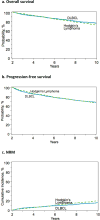Long-term outcomes among 2-year survivors of autologous hematopoietic cell transplantation for Hodgkin and diffuse large b-cell lymphoma
- PMID: 29125192
- PMCID: PMC5871233
- DOI: 10.1002/cncr.31114
Long-term outcomes among 2-year survivors of autologous hematopoietic cell transplantation for Hodgkin and diffuse large b-cell lymphoma
Abstract
Background: Autologous hematopoietic cell transplantation (auto-HCT) is a standard therapy for relapsed classic Hodgkin lymphoma (cHL) and diffuse large B-cell lymphoma (DLBCL); however, long-term outcomes are not well described.
Methods: This study analyzed survival, nonrelapse mortality, late effects, and subsequent malignant neoplasms (SMNs) in 1617 patients who survived progression-free for ≥2 years after auto-HCT for cHL or DLBCL between 1990 and 2008. The median age at auto-HCT was 40 years; the median follow-up was 10.6 years.
Results: The 5-year overall survival rate was 90% (95% confidence interval [CI], 87%-92%) for patients with cHL and 89% (95% CI, 87%-91%) for patients with DLBCL. The risk of late mortality in comparison with the general population was 9.6-fold higher for patients with cHL (standardized mortality ratio [SMR], 9.6) and 3.4-fold higher for patients with DLBCL (SMR, 3.4). Relapse accounted for 44% of late deaths. At least 1 late effect was reported for 9% of the patients. A total of 105 SMNs were confirmed: 44 in the cHL group and 61 in the DLBCL group. According to a multivariate analysis, older age, male sex, a Karnofsky score < 90, total body irradiation (TBI) exposure, and a higher number of lines of chemotherapy before auto-HCT were risk factors for overall mortality in cHL. Risk factors in DLBCL were older age and TBI exposure. A subanalysis of 798 adolescent and young adult patients mirrored the outcomes of the overall study population.
Conclusions: Despite generally favorable outcomes, 2-year survivors of auto-HCT for cHL or DLBCL have an excess late-mortality risk in comparison with the general population and experience an assortment of late complications. Cancer 2018;124:816-25. © 2017 American Cancer Society.
Keywords: Hodgkin lymphoma; autologous hematopoietic cell transplant; diffuse large B-cell lymphoma; late effects; nonrelapse mortality; survival.
© 2017 American Cancer Society.
Conflict of interest statement
None of the authors have any relevant conflict of interest to disclose.
Figures
References
-
- Philip T, Guglielmi C, Hagenbeek A, et al. Autologous bone marrow transplantation as compared with salvage chemotherapy in relapses of chemotherapy-sensitive non-Hodgkin’s lymphoma. N Engl J Med. 1995;333:1540–5. - PubMed
-
- Hazar V, Kesik V, Aksoylar S, et al. Outcome of autologous hematopoietic stem cell transplantation in children and adolescents with relapsed or refractory Hodgkin’s lymphoma. Pediatr Transplant. 2015;19:745–52. - PubMed
-
- Garfin PM, Link MP, Donaldson SS, et al. Improved outcomes after autologous bone marrow transplantation for children with relapsed or refractory Hodgkin lymphoma: twenty years experience at a single institution. Biol Blood Marrow Transplant. 2015;21:326–34. - PubMed
-
- Lazarus HM, Loberiza FR, Jr, Zhang MJ, et al. Autotransplants for Hodgkin’s disease in first relapse or second remission: a report from the autologous blood and marrow transplant registry (ABMTR) Bone Marrow Transplant. 2001;27:387–96. - PubMed
Publication types
MeSH terms
Grants and funding
LinkOut - more resources
Full Text Sources
Other Literature Sources
Medical


